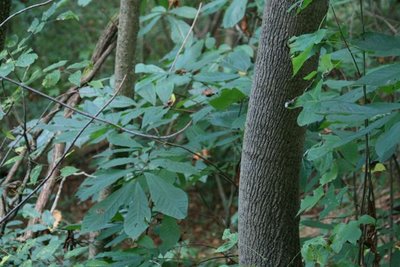
I’ll admit it. As a card-carrying denizen of Appalachia, the first pawpaw I ever picked and ate was this year. I can tell you it will not be the last.
The pawpaw (Asimina triloba) is an ancient tree in the Annonaceae (Custard-Apple) family that I had known only as an understory shrub, a gangly, thin-trunked thing that holds its huge ovate leaves in fives and sixes and rarely fruits.
 On a recent trip along the bike trail from Athens to Nelsonville, I finally saw the Real Pawpaw. (Above, the Real PaPaw, hiding behind a pawpaw). Juvenile leaves, called shade leaves, are enormous; mature trees dial leaf size back to something more normal. Leaf size is influenced in large part by the amount of sunlight reaching the tree. Less sunlight stimulates the tree to put out huge, thin leaves in an attempt to gather as much light as possible.
On a recent trip along the bike trail from Athens to Nelsonville, I finally saw the Real Pawpaw. (Above, the Real PaPaw, hiding behind a pawpaw). Juvenile leaves, called shade leaves, are enormous; mature trees dial leaf size back to something more normal. Leaf size is influenced in large part by the amount of sunlight reaching the tree. Less sunlight stimulates the tree to put out huge, thin leaves in an attempt to gather as much light as possible.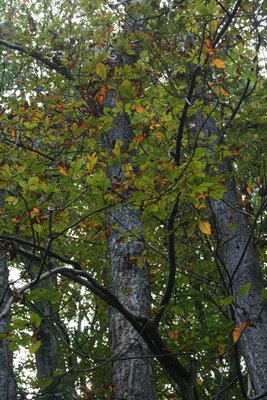
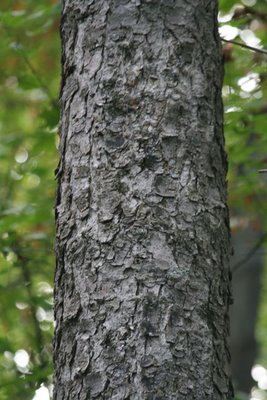 their tired autumnal leaves going burnt brown. Huge trees with green fruit the size of new potatoes hanging beneath the leaves. Real pawpaws.
their tired autumnal leaves going burnt brown. Huge trees with green fruit the size of new potatoes hanging beneath the leaves. Real pawpaws.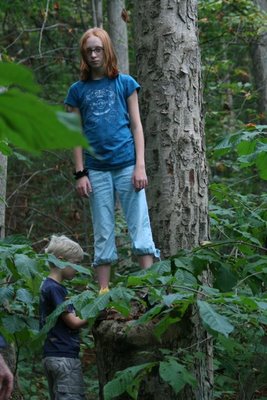
I am happy to say that I had a handsome caveman with me, who was only too happy to hurl some branchtes at the trees to try to dislodge the still-green fruit.
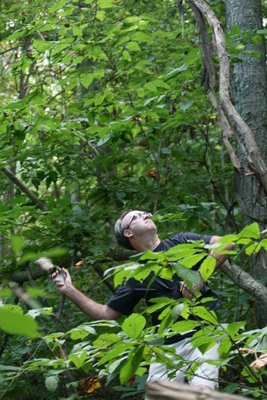
Ragnar want pawpaw!
Urrf!
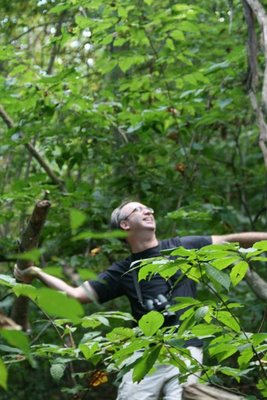
We’d been told by a friendly biker with his pockets full of pawpaws that we could shake the trees to dislodge the fruit, take them home, and wait for them to ripen like bananas on our windowsill. Clearly, he had been shaking the smaller trees all afternoon, so it was thin pickings for our little band of hungry gatherers. And over a certain DBH (diameter at breast height), you don't shake a pawpaw tree. We worked at it for awhile, though. It was hard to believe the rock-hard green ovoids would ever yield delicious flesh, but we shook a bunch of small trees and hurled sticks at big ones until we had about a dozen pawpaws in our backpack.
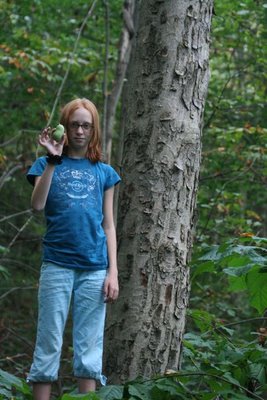
It’s been a week now, and the aroma of ripe pawpaws fills the kitchen. Peeling the fruit yields a hopeful orangey flesh.
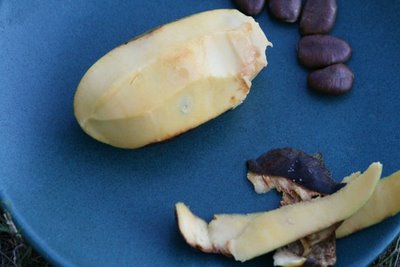
I was shocked upon cutting into my first fruit to find it stuffed so full of seeds that it was barely a fruit. It was more of a soft capsule of seeds, cushioned by flesh. What in the world?? What could all the fuss be about, when it's more seeds than fruit? This'n had nine seeds the size of Fordhook limas inside. Phew!
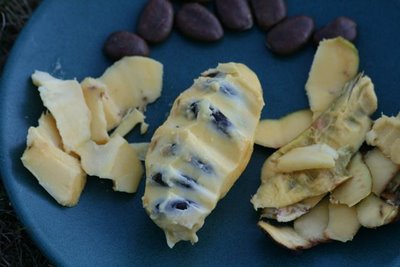 It was only four inches long. That's a lotta seeds. Edible slices to the left, peels to the right, seeds from a prior conquest above.
It was only four inches long. That's a lotta seeds. Edible slices to the left, peels to the right, seeds from a prior conquest above.What little flesh was there, though, was so succulent, so richly redolent of mango, banana, and pineapple, that I found myself tearing off little bits of it and stuffing them into my mouth. With considerable difficulty, I convinced Liam and Phoebe to at least try it, and immediately found myself fighting them for the last scraps. Kids know good stuff when they taste it.
So I thought about pawpaws in a new way.
What does the pawpaw want?
It wants someone or something to disperse those enormous seeds.
How does it accomplish that goal?
It cushions the seeds in a fruity pericarp so delicious, so sticky, so irresistible, that medium to large-sized mammals wolf it down, and swallow the huge, slick seeds in the process.
 Exhibit A. Large mammal, or pawpaw dispersal agent.
Exhibit A. Large mammal, or pawpaw dispersal agent.I came close to swallowing two pawpaw seeds in my quest to separate them from the delicious flesh of the fruit. I’m sure they’d have passed along just fine, despite their size, for they’re as slick as Chinese chestnuts. However, I’m not sure that our septic tank is precisely where the pawpaw hopes they will end up. For that, it prefers to dupe raccoons, opossums, deer, coyotes and foxes, who will gorge on the sweet fruit and poop out its seeds somewhere else the next night. This photo, from January. I'm not at all sure where the coon found pawpaws in January; ours get ripe in late September. Someday I may solve that particular mystery.** But there are so many mysteries, I usually have to work on a bunch at once.
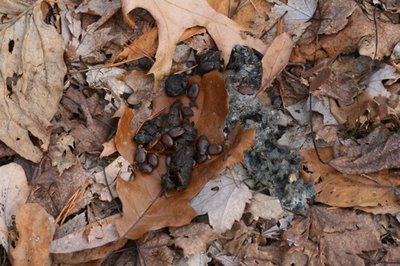
Large mammal gobbles fruit, ingests seeds, takes them elsewhere, plants them in a dollop of rich fertilizer. That is what the pawpaw wants.
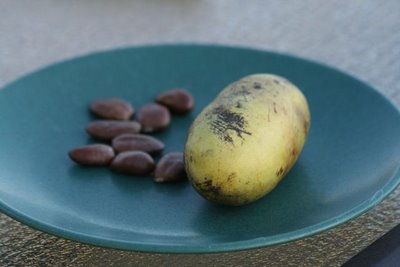 And what I want is more pawpaws.
And what I want is more pawpaws.**Since writing the post above, I have made further observations on pawpaws. And I can say, with a sample size of three large mammals who have been repeatedly polled about what my mother would refer to as "regularity," that the pawpaw apparently wants said mammals to carry its seeds a long, long way before depositing them. One would think that stuffing oneself on a sweet, delicious, pulpy fruit would have a swift and possibly explosive impact. This appears not to be the case. Bananas are the only other fruit I can think of (with the possible exception of persimmons) that have a binding effect. Perhaps the folk name "Missouri banana" describes more than flavor.
Buhhhmmer.
Oh. My God. That poor, poor January raccoon.






17 comments:
Looking at the size of the fruit/seeds I can't help but think they may have evolved as a result of the company of bigger game - they look like perfect little morsels for megafauna!
No kidding, poor raccoon!!
I'm hoping to plant a couple (or more if a friend will spare them) in our woods this fall--in a dim corner where they'll settle in well beneath our large oaks.
I learned this summer that Zebra Swallowtails rely on PawPaws for their host plant.
Not a bad pay-off: Beautiful butterflies and tasty fruit!
How's that raccoon?
The first time I saw a pawpaw fruit, I was hiking with friends in NC. None of us had ever seen one before, and we had no idea what it was. One of my more adventurous friends tried eating one, and I was horrified. When we got back, we looked them up and I was reieved to learn that they are indeed edible.
Zebra swallowtails use the Paw-Paws as their host plant - I know they're around here somewhere...
"However, I’m not sure that our septic tank is precisely where the pawpaw hopes they will end up." Hysterical!
Chloe could have used some of that fruit yesterday.
Thanks for the laughs.
Mary
Yay, you were in my neck of the woods (Athens County)! Isn't the bike path just lovely, especially this time of year?
We have some Pawpaw trees on our property (of the young, gangly understory variety), and I've yet to see them bear fruit. It's kind of discouraging. Maybe someday. You just missed the annual Pawpaw festival at Lake Snowden in Albany a few weeks back. Glad you finally had your first tasting experience. Oh, and I always wondered what Bill's caveman name was...
What? No photos of the bikes?
This makes me think of Michael Pollen's "Botany of Desire" and his theory that some plants use humanity to promote their own survival by making themselves desirable to people who spread them by breeding and cultivation.
Ha! Ha! Laughing out loud. Poor, poor raccoon.
Asimina triloba (paw paw) has been investigated for use as a pesticide and as an anti-cancer agent. The active ingredients are called acetogenins. I once tried to separate the seeds from the pulp using a Foley food mill and the resultant product was quite toxic due to the seed coats rubbing off into the pulp. Needless to say we through it out....
Now this is the second blog post I've seen on PawPaws and I am curious to try this succulent fruit.
Mojo--so good to see you here. I have been steeped in Pollan (and pollen) of late. Busted.
Mas non, Heather, we made the paw paw festival on Sunday, the kids, Chet and I. You know the blog ant...it takes me awhile. It wasn't nearly as fun as last year. Too windy thanks to hurricane remnants. The HockHocking Adena Bike Path RAWKS.
Michael, I'll blog on processing pawpaws in a later post. I've figured out what works for me. It ain't easy but it's fun.
Toni, you can order the frozen pulp online--it comes in orangeish blocks. I have ziploc bags full of my own pawpaw pulp in the freezer. Good in smoothies! although it doesn't exactly make us ...smooth.
I just kept hearing a song in my head about a PawPaw patch... what's that about? It's on a tree for goodness sakes, and now I want to try one too! I truly had no idea it was considered a fruit.
I don't believe we have paw paws in NH, but I did spend an hour on Sunday investigating a wild grapevine that had lots of fruit running straight up a young tree - the bunches I could get to wihthout a ladder or wings were pretty tasty - lightly sweet and a touch of tart. This is the first year I've seen it make fruit. I wonder if my septic system will handle wild grapes differently than store bought. I too have been reading Michael Pollan (Omnivore's Dilemma)and marvelling at the difference it's made in my perspectives. Interesting, thought provoking and fun to read stuff - even for a devoted novel reader.
I came across an old article about turtle watching from the NH paper, the Keene Sentinel while searching for snapping turtle info online and thought I'd share. The first few paragraphs had me howling - and also describe my birding skills to a tee!
http://www.almostgruntled.com/stories/Sentinel/turtle.html
I think perhaps the mark of the best nature blogs is that, sooner or later (perhaps usually sooner) they come around to discussing scat.
Nice post.
I hate to admit it, but I never even knew pawpaws grew in North America. About all I knew about them was that bears in India love the fruit -- learned that one from Disney!
"Now when you pick a pawpaw, or a prickly pear, and you prick a raw paw... Well, next time beware. Don't pick the prickly pear by the paw, when you pick a pear try to use the claw. But you don't need to use the claw when you pick a pear of the big pawpaw!"
Oh, the lessons you learns....
Thanks, mdmnm. I heartily concur that poop is at the root of most interesting natural history events.
Kyle, an online search for pawpaw will turn up as many references to papayas (a true tropical) as it does to North American pawpaws. I suspect that your confusion resides in that unfortunate fact. Truly, though, the American pawpaw is an underappreciated fruit.
Hey, I think you captured an image of Sasquatch in that pawpaw leaf photo.
Jen,
Pawpaws will probably grow in NH. I've got a couple in my yard near Boston, and I hear that their natural range include Michigan. I got mine mail-order from Edible Landscaping (eat-it.com), you need two different varieties to make fruit, and hand-pollination helps. Expect 10 years from stick to fruiting.
Post a Comment